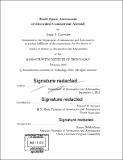| dc.contributor.advisor | Edward M. Greitzer. | en_US |
| dc.contributor.author | Gonzalez, Jonas J. | en_US |
| dc.contributor.other | Massachusetts Institute of Technology. Department of Aeronautics and Astronautics. | en_US |
| dc.date.accessioned | 2019-10-11T21:53:33Z | |
| dc.date.available | 2019-10-11T21:53:33Z | |
| dc.date.copyright | 2019 | en_US |
| dc.date.issued | 2019 | en_US |
| dc.identifier.uri | https://hdl.handle.net/1721.1/122503 | |
| dc.description | Thesis: S.M., Massachusetts Institute of Technology, Department of Aeronautics and Astronautics, 2019 | en_US |
| dc.description | Cataloged from PDF version of thesis. | en_US |
| dc.description | Includes bibliographical references (pages 105-106). | en_US |
| dc.description.abstract | This thesis assesses the performance benefit of electrified propulsion systems for commercial aircraft entering production in a 2035 timeframe. The propulsive power reduction from boundary layer ingestion (BLI), a technology that could be enhanced by electrification, is characterized and bounded by power balance analysis. An aircraft system model extends this analysis to capture the weight and performance trades of electrified architectures, as defined by propulsion system configuration, technology level, and mission. The model quantifies the impact of such architectures on mission energy via optimized aircraft designs. It is found that the propulsive power of a representative narrow-body jet is reduced by 28% with ideal ingestion of the entire boundary layer. Distributed, boundary layer ingesting, turbo-electric aircraft configurations are found to minimize energy consumption for all the missions examined from 500 to 6000 nmi. Energy reductions up to 27% relative to a non-BLI, non-electric, twin-turbofan design are possible. Advanced non-electric aircraft configurations are also examined and found to achieve similar reductions (up to 24%) with fuselage BLI. A parametric characterization of the trade space of electrified configurations illustrates the benefit of a turbo-electric architecture for all the technology levels and missions examined and the limitation of all-electric architecture to mission ranges less than 300 nmi, even with optimistic technology levels. | en_US |
| dc.description.statementofresponsibility | by Jonas J. Gonzalez. | en_US |
| dc.format.extent | 106 pages | en_US |
| dc.language.iso | eng | en_US |
| dc.publisher | Massachusetts Institute of Technology | en_US |
| dc.rights | MIT theses are protected by copyright. They may be viewed, downloaded, or printed from this source but further reproduction or distribution in any format is prohibited without written permission. | en_US |
| dc.rights.uri | http://dspace.mit.edu/handle/1721.1/7582 | en_US |
| dc.subject | Aeronautics and Astronautics. | en_US |
| dc.title | Trade space assessment of electrified commercial aircraft | en_US |
| dc.type | Thesis | en_US |
| dc.description.degree | S.M. | en_US |
| dc.contributor.department | Massachusetts Institute of Technology. Department of Aeronautics and Astronautics | en_US |
| dc.identifier.oclc | 1121198612 | en_US |
| dc.description.collection | S.M. Massachusetts Institute of Technology, Department of Aeronautics and Astronautics | en_US |
| dspace.imported | 2019-10-11T21:53:32Z | en_US |
| mit.thesis.degree | Master | en_US |
| mit.thesis.department | Aero | en_US |
